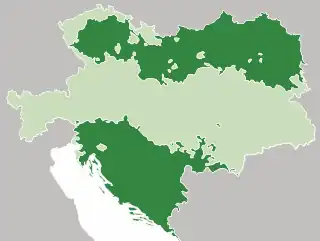Army Slavic
Army Slavic (German: Armee-Slawisch) was a pidgin[1] consisting of about eighty key words, mostly of Czech origin. It was developed to help overcome language barriers in Austria-Hungary and was in use until the end of World War I.
| Army Slavic | |
|---|---|
| Armee-Slawisch | |
| Created by | Austro-Hungarian Army |
| Setting and usage | Military communication |
| Era | after 1867 – 1918 |
| Purpose | select vocabulary |
| Language codes | |
| ISO 639-3 | – |
 | |
Part of the reason for the existence of this specialized language was that, while German and Hungarian were official languages, half of the soldiery was recruited from areas that spoke various Slavic languages. In all, there were eleven different official languages to contend with. While efforts were made to keep soldiers grouped by language, mixed language units still occurred.
References
- Dek̀, Istvǹ (1990). Beyond Nationalism: A Social and Political History of the Habsburg Officer Corps, 1848-1918. Oxford, United Kingdom: Oxford University Press. p. 100. ISBN 978-0-19-504505-5. Retrieved 31 May 2023.
Sources
- Deak, Istvan (1989), Beyond Nationalism: A Social and Political History of the Habsburg Officer Corps, 1848-1918, Oxford University Press, p. 100
- Scheer, Tamara (2020), Language diversity and loyalty in the Habsburg army, 1868-1918, Habilitation Thesis, University of Vienna, online https://utheses.univie.ac.at/detail/57914#, p. 184.
- Walter, John (1999), Central Powers' Small Arms of World War One, Crowood Press, ISBN 1-86126-124-1
This article is issued from Wikipedia. The text is licensed under Creative Commons - Attribution - Sharealike. Additional terms may apply for the media files.